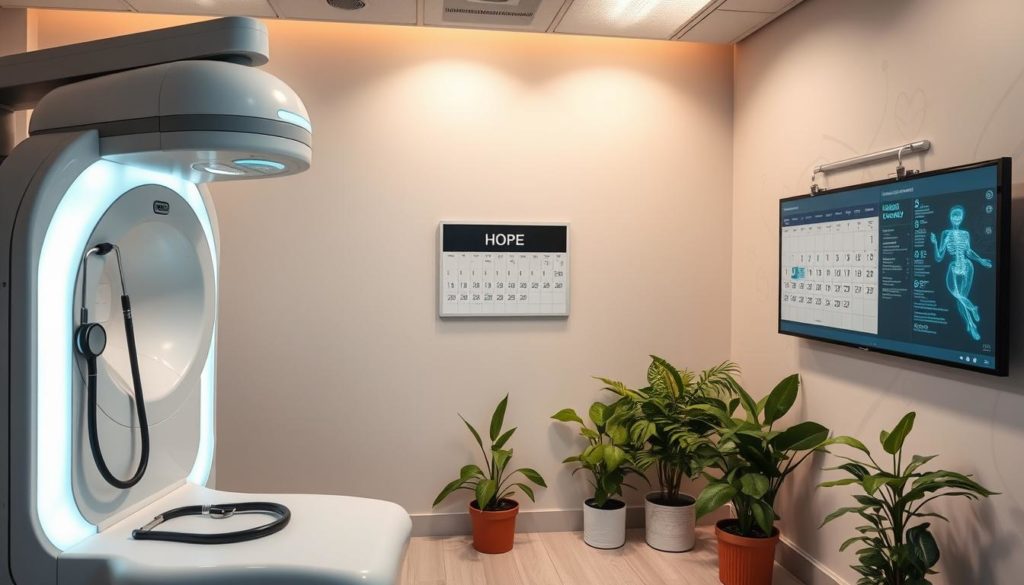Survivors of prostate cancer often deal with cancer recurrence monitoring and the risk of new cancers after beating prostate cancer. The American Cancer Society has medically reviewed this guide. It covers follow-up care, the importance of health insurance, and keeping detailed medical records.
Cancer can come back or new ones may develop, which shows the need for detailed check-up plans. Understanding long-lasting side effects of treatments is also key. Survivorship care plans play a vital role; they keep track of your treatment history. They also help in scheduling follow-up exams and tests.
It’s important to deal with the emotional and psychological effects of surviving prostate cancer. Finding support resources and strategies to maintain mental health is essential for coping with these long-term impacts.
Understanding the Risk of Second Cancers for Prostate Cancer Survivors
Prostate cancer survivors have a higher second cancer risk. This risk increases with certain treatments. For example, radiation therapy raises the chance of getting other cancers. These include cancers of the small intestine, soft tissue, bladder, thyroid, thymus, and skin melanoma.

Radiation techniques have gotten more precise. They now target cancer cells better and protect healthy tissue. But, long-term risks still exist. Modern radiation methods are improving safety. However, it’s important for survivors to know about these risks. Being aware helps survivors follow preventive care and highlights follow-up care for prostate cancer survivors.
Being informed and watchful can lower second cancer risks. Knowing the risks linked to prostate cancer treatment helps. It leads to better health monitoring and outcomes over time.
Post-Treatment Surveillance: Why It’s Crucial
After prostate cancer treatment, staying healthy means keeping up with Post-Treatment Surveillance. It’s vital for handling Prostate Cancer Treatment Side Effects. It also helps spot signs of Prostate Cancer Recurrence Monitoring quickly.

Regular Doctor Visits
Seeing your doctor often is key. You might have PSA tests, digital rectal exams, and talks about any new symptoms. These visits are crucial for catching and dealing with problems early, making them a big part of Post-Treatment Surveillance.
PSA Tests and Imaging
PSA tests are important for Prostate Cancer Recurrence Monitoring. They check if PSA levels go up, hinting at cancer coming back. Imaging tests like bone scans or PET scans also play a big role. They look for cancer spread or new issues early on.
Monitoring Symptoms
It’s critical to watch for symptoms closely as part of Post-Treatment Surveillance. Be alert for things like ongoing bone pain, weight loss, or urinary problems. Quick action can lead to better care and handling of Prostate Cancer Treatment Side Effects.
Factors Contributing to Second Cancer Risk
After surviving prostate cancer, some people may face the chance of getting a second cancer. This can happen for many reasons. Genetics can be a big factor. This means some people’s genes make them more likely to get other cancers.
Another reason is radiation therapy, a usual treatment for prostate cancer. It can raise the chance of getting bladder and colorectal cancers. Choices we make in our lives can also affect this risk.
Research shows that smoking and not eating well can make this risk worse. Especially for those who’ve had radiation therapy. Smokers seem to get bladder cancer more than non-smokers do.
To lower this risk, we need a good plan. Lifestyle modifications like stopping smoking and eating healthier are key. By understanding what increases the risk, we can better prevent and treat these second cancers.
Follow-Up Care for Prostate Cancer Survivors
After beating prostate cancer, follow-up care is key. Survivors need a solid plan to watch their health and tackle any risks. This care is vital for a survivor’s journey to wellness.
Survivorship Care Plans
Survivorship Care Plans are crucial for those who’ve beaten prostate cancer. They map out your treatment history and when to have check-ups. They also watch for side effects over time. Having a detailed plan helps keep your health in check and catches any issues early.
Importance of Health Insurance
For survivors, health insurance is a must. It pays for important tests and treatments if the cancer comes back. It’s important to have a policy that covers all you need for peace of mind. Insurance eases the worry about healthcare costs.
Maintaining Medical Records
Managing your medical records is crucial. It’s especially important when you switch doctors. Well-kept records mean your new doctor knows your history. This helps make sure you get the best care moving forward.
Common Types of Second Cancers After Prostate Cancer
Prostate cancer survivors face a higher chance of getting other cancers. Knowing these risks helps with early detection and treatment.
Bladder Cancer
Secondary bladder cancer is common after prostate cancer. It’s mainly seen in those who had radiation therapy. The bladder, being close to the prostate, gets exposed to radiation. Research shows men with radiation treatment face a higher bladder cancer rate than those with surgery.
Soft Tissue Cancer
Soft tissue cancer is also a risk after prostate cancer. It includes cancers in muscles, fat, and blood vessels. It’s more common in those with long-term radiation treatment. Regular doctor visits and quick action on any odd symptoms are key.
Melanoma of the Skin
Melanoma is a serious risk for prostate cancer survivors. Those who had radiation or hormone therapy may have a higher risk. It’s aggressive and needs early detection. Regularly checking the skin and watching for new moles are important steps.
Impact of Radiation Therapy on Second Cancer Risk
Survivors of prostate cancer often go through Radiation Therapy in their treatment. This method helps control the main cancer but has Prostate Cancer Treatment Side Effects. It notably raises the chance of getting Radiation-Induced Malignancies in the bladder and rectum.
Advanced techniques like Intensity-Modulated Radiation Therapy (IMRT) aim to hit tumors with precision. But, they can still increase the dose to healthy tissues, raising the risk of secondary cancers. This shows why it’s vital to balance the gains of radiation with its long-term risks.
| Treatment Type | Primary Usage | Risks |
|---|---|---|
| External Beam Radiation Therapy | Targeting Prostate Tumors | Bladder and Rectum Cancer |
| Intensity-Modulated Radiation Therapy (IMRT) | Precise Tumor Targeting | Higher Integral Dose to Normal Tissues |
| Brachytherapy | Localized Radiation Delivery | Potential Carcinogenic Risk to Surrounding Tissues |
Talking about potential side effects is a must when planning radiation treatments. Watching closely for any secondary malignancies after treatment ensures quick and proper care.
Preventive Measures and Healthy Lifestyle Changes
After prostate cancer treatment, taking preventive steps and changing life habits are key. This includes diet, activity, and stopping smoking.
Diet and Nutrition
A cancer prevention diet can help those who have had prostate cancer. Eating lots of fruits, veggies, and whole grains is smart. It lowers the risk of dying from prostate cancer. Adding things like broccoli and leafy greens brings extra cancer-fighting power.
Physical Activity
Staying active cuts the risk of cancer coming back. Studies show being active lowers death rates from prostate cancer. Try to get 150 minutes of moderate exercise or 75 minutes of something tougher every week. Walking, biking, and strength exercises are good. They keep your heart healthy and help you manage weight and stress.
Quitting Smoking
Stopping smoking boosts your health and prevents cancer coming back. Stopping smoking helps not just your lungs but also lowers the chance of more cancers. Getting help through programs and counseling works. Quitting smoking makes life better and longer.
For more on staying healthy after prostate cancer, check the American Cancer Society’s guide.
Signs and Symptoms to Watch for in Second Cancers
For prostate cancer survivors, staying alert about cancer coming back is key. Spotting signs early of another cancer is vital. Here are important signs to watch:
- New or Unusual Pain: If you feel pain that doesn’t go away or can’t be explained, it could be a sign. Tell your healthcare provider right away.
- Significant Weight Loss: Losing weight without trying can be a sign of many cancers. Note any weight changes and talk about them at your prostate cancer follow-up care meetings.
- Changes in Urinary or Bowel Habits: Changes in how often you go, finding it hard, or seeing blood means you should see a doctor fast. This could point to another cancer.
Reporting these symptoms fast can help start early treatment. This could make a big difference. By knowing these signs, patients and doctors can work together closely.
| Symptom | Potential Indication | Action |
|---|---|---|
| New or Unusual Pain | Possible secondary cancer | Report immediately to your doctor |
| Significant Weight Loss | Possible various cancers | Notify your healthcare provider |
| Changes in Urinary/Bowel Habits | Possible secondary cancer | Seek medical evaluation promptly |
Importance of Emotional and Psychological Support
After prostate cancer treatment, dealing with emotions and psychological changes is key. Many people worry about cancer coming back, changes in their body, or getting used to a new daily life. Emotional Support for Cancer Survivors is very important. It helps people be strong and hopeful as they move forward.
Seeking Professional Help
Professional counseling provides a private space for survivors to talk about their fears and feelings. Oncology therapists can teach coping strategies for the mental effects of cancer. It’s critical to tackle mental health issues early. This avoids feelings of loneliness or sadness from getting worse.
Support Groups and Community Resources
Meeting others who have faced similar challenges can be very comforting. Prostate Cancer Support Groups let survivors share stories, give advice, and support each other. Community groups, like local cancer centers, often have workshops and seminars to help survivors.
Maintaining Mental Health
Taking care of your mental health is just as important as looking after your physical health. Activities like mindfulness, meditation, and exercise can improve your overall health. It’s also crucial to talk to a health professional about issues such as sexual dysfunction or incontinence. This helps keep a positive and realistic view on life after treatment.
Having a strong support system makes a big difference in this tough time. It’s about creating a strong network that includes Emotional Support for Cancer Survivors, being active in Prostate Cancer Support Groups, and focusing on both Mental Health and Cancer care.
FAQ
What are the most common types of second cancers for prostate cancer survivors?
If you’ve had prostate cancer, you may get other cancers later. These include bladder, soft tissue, and skin cancers. Radiation therapy makes this risk higher.
Why is post-treatment surveillance critical for prostate cancer survivors?
Watching health closely after treatment is key. Prostate cancer can come back. Regular checks can catch recurrences or new cancers early.
How can prostate cancer survivors reduce their risk of second cancers?
Living healthy is a big step. Eat well, move more, and stop smoking. It’s also good to keep up with doctor’s visits and have a care plan.
What role do survivorship care plans play for prostate cancer survivors?
Care plans track your treatment history. They guide you on when to have exams and tests. This helps watch for side effects or new cancers.
How does radiation therapy impact the risk of second cancers?
Radiation helps fight prostate cancer. But, it can also lead to other cancers like those in the bladder or rectum. New tech tries to lower these risks.
What signs should prostate cancer survivors watch for that might indicate a second cancer?
Stay alert for new pain, losing weight fast, or changes in your bathroom habits. Tell your doctor right away. Early action means better chances.
How important is it to maintain health insurance after prostate cancer treatment?
Health insurance is a must. It covers tests and treatments if cancer comes back. It keeps you connected to your doctors, too.
What are the potential long-term side effects of prostate cancer treatment?
Treatments may lead to problems like not being able to control urine or sexual issues. They could also raise the chance of getting another cancer. Care plans can help manage these.
How can prostate cancer survivors manage the emotional and psychological impact of their diagnosis?
Support for your feelings is out there. Talking to a therapist, joining groups, and finding resources can help. They guide you in your recovery journey.
Why is keeping detailed medical records important for prostate cancer survivors?
Good records make your care smoother, especially if you see new doctors. They share your history and future care steps.


